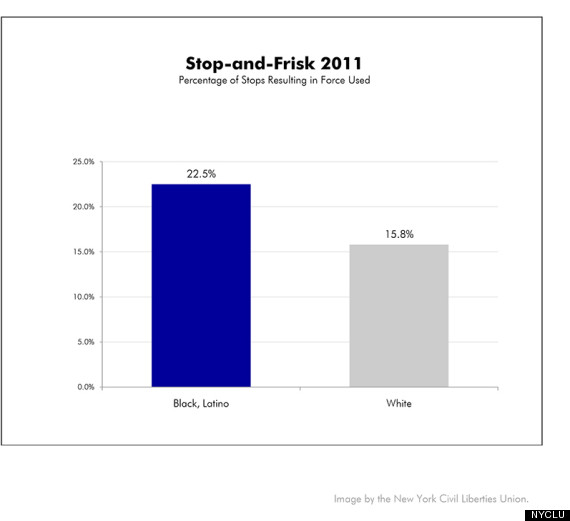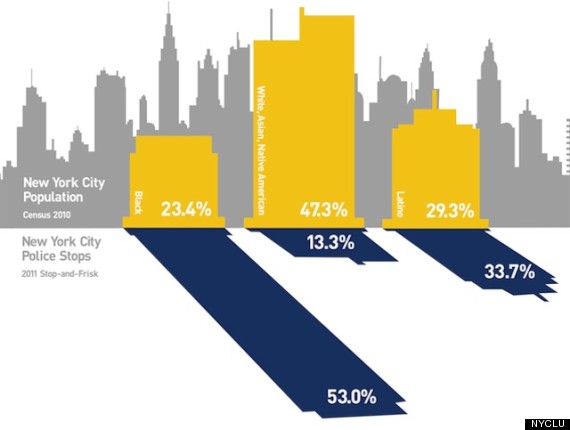The stop and frisk law is one of the most controversial police procedures in the modern crime prevention world today. This law was created to try to reduce crime on the streets and try to catch people with concealed weapons before they are used. What I am going to explore is whether or not this procedure violates the 4th amendment of unreasonable search and seizures as well as examine statistics to prove this procedure effective or not.
How the law is enforced
The way this law is enforced is that policemen or women will patrol an area of his or her choice, usually by car, and look out for anything that he or she believes to be suspicious. According to huffingtonpost.com, the officers can even stop and frisk someone inside a building if they have permission from the landlord. When he or she does find something suspicious they will stop that person and proceed to do a brief pat down of the outer garments. If nothing is found then that person will be released. If a weapon or any other illegal substance is found, that person will be arrested and brought into police custody for questioning. The main complaint that people have is that this search goes against their constitutional rights because they are being searched without a warrant. It is also a hassle and an inconvenience to have policemen stopping you to pat you down. According to HP, in a 2009 report by the New York Civil Liberties Union, 93 out of 100 residents in Brownsville, Brooklyn were stopped by the NYPD for a stop and frisk procedure. Another statistic also shows that force is used more often in stops with Latinos and blacks than there is with whites, which goes along with people accusing cops of being more aggressive with certain races.
According to Findlaw, The fourth amendment is defined as the right of the people to be secure in their persons, houses, papers, and effects, against unreasonable searches and seizures, shall not be violated, and no Warrants shall issue, but upon probable cause, supported by Oath or affirmation, and particularly describing the place to be searched, and the persons or things to be seized. Basically, it protects citizens from police officers or any other member of law enforcement trying to search or take anything from you without a warrant or reasonable suspicion. The reasonable suspicion part is where there is a very thin line that causes a lot of dispute. Statistics show that blacks and Latinos have been stopped way more than whites. This instigates an argument of racism. In my interview with Mr. Bittinger, he explains why despite all of the complaints of policemen needing probable cause to search someone, this policy, in fact, does not violate the fourth amendment. Even though the policy is constituional, the stops sometimes are not. There are very strict rules that NYPD have not been following that make the stops unconstitutional. According to HP, 30% of all stops are unconstitutional.
The argument goes both ways in this case. Most people say that this is a good idea and will be successful in reducing crime, but many people complain about being stopped for no reason and waste time being searched. In my mind and in the law enforcer’s minds, it is worth stopping and searching innocent people some of the time in order to catch the real criminals before crimes are committed. I asked another expert the same two questions that I asked Mr. Bittinger and got more interesting input. I asked: Does this policy violate the 4th amendment and is there data proving this effective.
How is it working so far?
Studies show that the stop and frisk policy is an effective crime deterrence and has reduced crime in many cities. The bottom line is that this is a great way to prevent crime before it happens, but what I am researching and we have to make sure of is that citizens rights are not being violated. The stop and frisk policy has not really been as effective as people thought it may be. According to HP, since 2003, stops have increased by over 524,000 and there have only been an additional 176 guns found. I thought this policy started to sound pointless so I asked Mr. B if he thought this was an effective deterrence to crime and if he thought it would continue to be used. Here is what he had to say:
Will we continue to use this crime prevention tactic?
With the minimal effectiveness of this crime prevention policy, many think that this will not last much longer and the stop and frisk policy will be put to an end in the coming years. One reason is that the NYPD has faced way to many lawsuits involving this policy and it is not worth it. Another thing is the most people stopped are innocent. According to HP, in 2011, 9 out of 10 stopped were neither arrested nor given summonses. You can find more statistics and useful information on this topic on this website.
After all, the policy that started a lot of controversy ends up not working out
After doing all of my research and talking to a couple of experts about this topic, my belief is that the toll this is taking on the citizens and police force of NYC both physically and mentally is not worth the minimal amount of crime prevention that the stop and frisk policy is doing. Here is one last opinion from a non-expert on the Stop and Frisk Policy.

